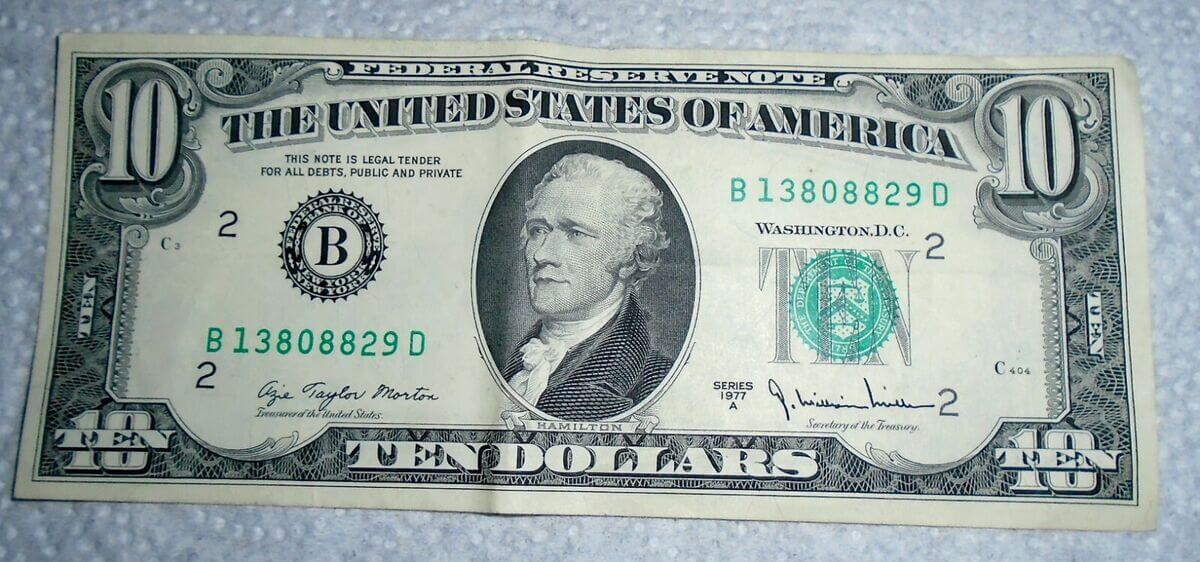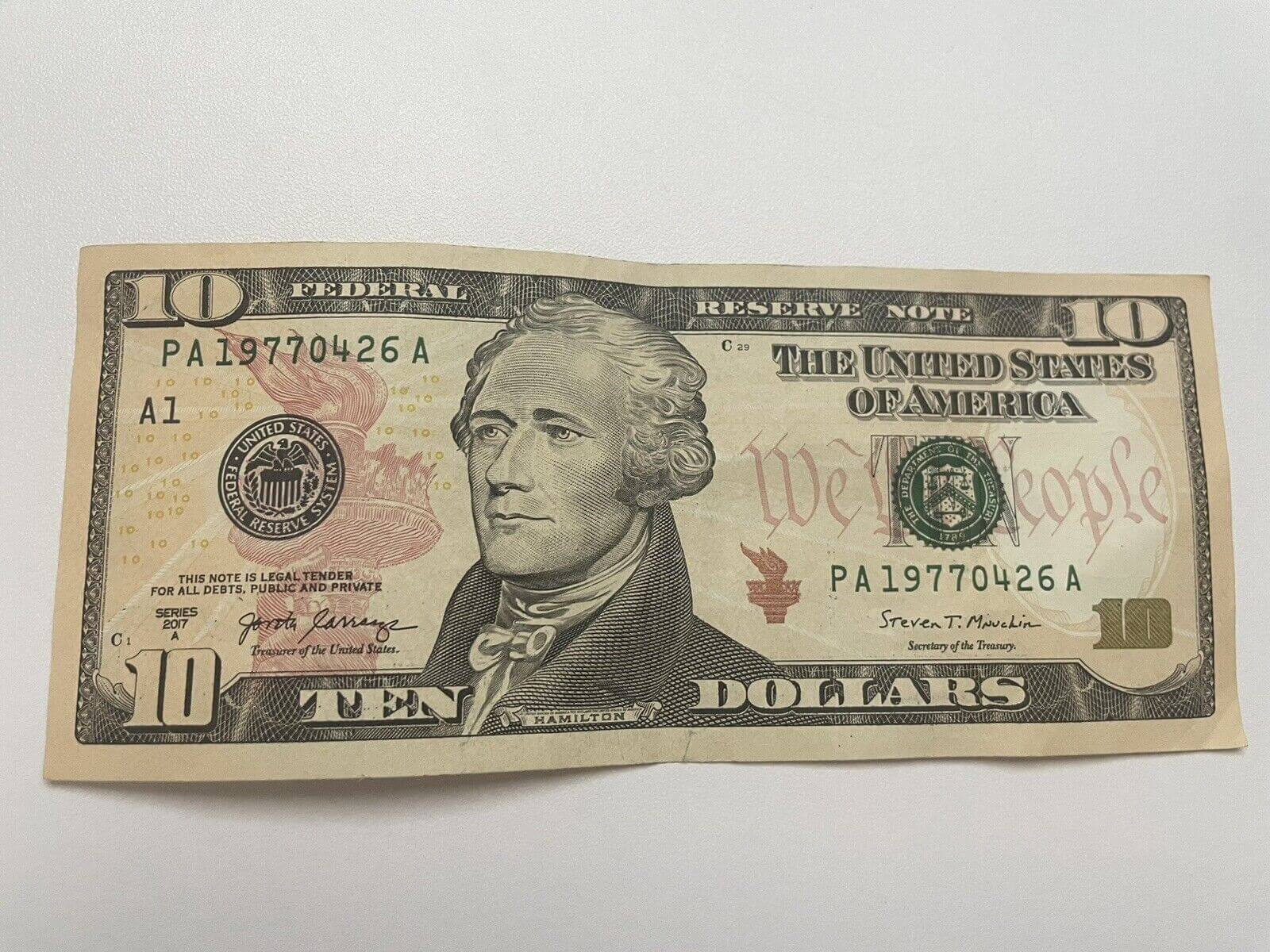If you’re a collector of currency or just curious about the value of older bills, you’ve probably come across the 1977 10 dollar bill. While many of these bills are not particularly valuable in and of themselves, there are some key factors that could make certain examples more interesting to collectors.
The 1977 $10 bill has its share of quirks that can significantly influence its worth.
In this article, we’ll explore the specifications, value, star notes, and grading system to help you understand whether your 1977 $10 bill is worth more than face value.
Specifications Of The 1977 $10 Bill
Before diving into its value, it’s important to understand the specifications of the 1977 $10 Federal Reserve Note. The 1977 series, which was printed in the mid-1970s, is part of a two-series set of currency issued by the United States during that time.

The two series are:
- Series 1977: This was the first issue of the $10 bill featuring the signature of Treasury Secretary William E. Simon and Treasurer of the United States Dorothy L. Hicks.
- Series 1977A: This series featured slight changes, including a modification in the Treasury Secretary’s signature, with the signature of Anthony Solomon replacing Simon’s.
These bills are issued in denominations of $10.00 USD and are classified as Federal Reserve Notes.
The obverse (front) side of the bill features the portrait of Alexander Hamilton, the first Secretary of the Treasury, while the reverse (back) includes images of the U.S. Treasury Building.
There are also security features, such as a security thread, to help prevent counterfeiting. These bills are part of a series known for their relatively simple design compared to the more intricate features of later currency designs.
Value Of The 1977 $10 Bill
For most people, the first question when coming across a 1977 $10 bill is: What is it worth? Generally, the value of a 1977 $10 bill is not much more than its face value unless it’s in particularly good condition or features special traits such as being a star note or having a printing error.
Circulated Condition
If the 1977 $10 bill has been in circulation and shows signs of wear, such as creases, folds, or fading, it is generally only worth its face value. For instance, a 1977 series $10 bill in average circulated condition might be worth just $10, unless it has a rare characteristic like a star note.
Uncirculated Condition
On the other hand, bills that have never been circulated, known as uncirculated bills, can fetch a higher price. A 1977 series $10 bill in extremely fine condition, which means it shows very little sign of circulation, might be worth around $15. If the bill is graded at MS 63 (choice uncirculated), it could be worth anywhere from $35 to $40.
1977A Series $10 Bill
The 1977A series bills tend to be slightly more valuable than the 1977 series bills. In extremely fine condition, a 1977A $10 bill might be worth $22.50, and an MS 63 graded uncirculated bill might go for $37.50.
Star Notes: A Valuable Variant
One of the most exciting aspects of collecting currency is the presence of star notes. These are replacement notes printed by the U.S. Treasury when a bill is damaged or misprinted during the printing process.
Instead of a standard serial number, star notes have a small star symbol at the end of the serial number.
Because they are produced in limited quantities, star notes tend to be much rarer and more valuable than regular bills.
Value of Star Notes for the 1977 $10 Bill
The 1977 $10 star notes, especially those from the Federal Reserve Bank of Minneapolis, can be worth more than their non-star counterparts. A star note from the 1977 series in extremely fine condition might be worth between $30 and $37.50, while an MS 63 uncirculated star note could sell for $80 to $90.
The 1977A series star notes are also valuable.
In extremely fine condition, these bills may be worth about $27.50, and in uncirculated MS 63 condition, they can reach prices around $82.50.
Why Star Notes Matter
Star notes are often seen as “scarcer” because the U.S. Treasury only prints a limited number of them to replace bills that have been damaged. This makes them more sought after among collectors, particularly those who focus on specific series like the 1977 $10 bills.

Furthermore, star notes from certain Federal Reserve Banks, especially smaller ones, can be even more valuable due to their relative rarity.
Misprints and Printing Errors
Like many other currency series, the 1977 $10 bills can sometimes contain printing errors or misprints that make them even more desirable to collectors. While the 1977 $10 bill doesn’t have as many known errors as some other bills, there are a few notable ones that can increase the value of a note:
- Mirrored Faces on the Reverse: One peculiar feature of the 1977 $10 bill is the misaligned back print, where the back design of the bill features a mirror image of the portrait on the front. This can occur during the printing process when an additional image of the face appears on the wrong side of the note. While this is an error, it is not necessarily common enough to drastically increase the value of the bill. However, it’s something to look out for when assessing your 1977 $10 bill.
- Offset Printing Errors: Another type of misprint that could occur is an offset error. This happens when ink from one side of the note unintentionally transfers to another part of the note. For example, in rare cases, the green ink from the back of the bill might shift slightly, creating an unusual pattern. This error is more likely to occur on 1977A series bills, though such misprints are not exceedingly valuable unless they are severe or unique.
How To Tell If Your 1977 $10 Bill Is Real?
In addition to the standard collection-related concerns, collectors may also wonder about the authenticity of their bills. Fortunately, the 1977 $10 bill comes with multiple security features to ensure that it’s real. These include:
- A security thread that runs vertically through the bill.
- Microprinting in various places, such as along the edges and within the bill’s design.
- Watermarks that can be seen when the bill is held up to light.
If you ever find yourself questioning the authenticity of a 1977 $10 bill, specialized lighting can help reveal hidden features like the faint glow of the serial numbers or security thread. If these features are absent, it’s possible that the bill is counterfeit.
Conclusion
Most 1977 $10 bills in circulated condition are not particularly valuable—just worth their face value of $10. However, if you come across a bill in excellent condition, or better yet, a star note, there could be significant value to be found.
These rare and unique bills can be worth a premium depending on their condition and the specific characteristics of the bill, like misprints or unusual features.
Collectors who specialize in U.S. currency will likely find that 1977 $10 bills—especially star notes and those with printing errors—are interesting additions to their collections. Whether you’re looking to sell, buy, or simply enjoy the history of these notes, there’s more to discover about the 1977 10 dollar bill than meets the eye.

